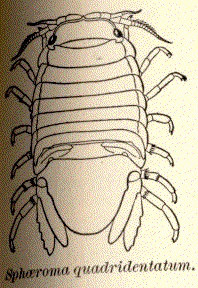| Sphaeroma quadridentatum | |
|---|---|
 | |
| Scientific classification | |
| Kingdom: | Animalia |
| Phylum: | Arthropoda |
| Class: | Malacostraca |
| Order: | Isopoda |
| Family: | Sphaeromatidae |
| Genus: | Sphaeroma |
| Species: | S. quadridentatum |
| Binomial name | |
| Sphaeroma quadridentatum Say, 1818 | |
Sphaeroma quadridentatum, the sea pill bug, is a species of isopod in the family Sphaeromatidae. [1] [2] [3]